Evaluating FRP Characterization: Raman, PL, AFM & SWOT Analysis
VerifiedAdded on 2023/06/11
|10
|3531
|405
Report
AI Summary
This report critically evaluates the application of Raman spectroscopy, photoluminescence (PL), and atomic force microscopy (AFM) techniques for characterizing fiber-reinforced plastic (FRP). It justifies the appropriateness of these techniques by highlighting their ability to analyze the chemical, molecular structure, bonding, and stress/strain properties of FRP, which are crucial for understanding its performance. A SWOT analysis is employed to discuss the strengths, weaknesses, opportunities, and threats associated with these techniques. The strengths include high resolution imaging, non-destructive analysis, and suitability for both organic and inorganic materials. Limitations include sensitivity challenges, slow scanning times, and potential interference from fluorescence. Improvements focus on advancements in technology to reduce noise, increase speed, and enhance detection capabilities. The report concludes by emphasizing the potential of these techniques in advancing the understanding and application of FRP materials in various industries. Desklib offers this report along with other solved assignments and past papers for students.

Advanced material 1
Advanced material characterization
Name:
Instructor:
Affiliation:
Course:
Date:
Advanced material characterization
Name:
Instructor:
Affiliation:
Course:
Date:
Paraphrase This Document
Need a fresh take? Get an instant paraphrase of this document with our AI Paraphraser
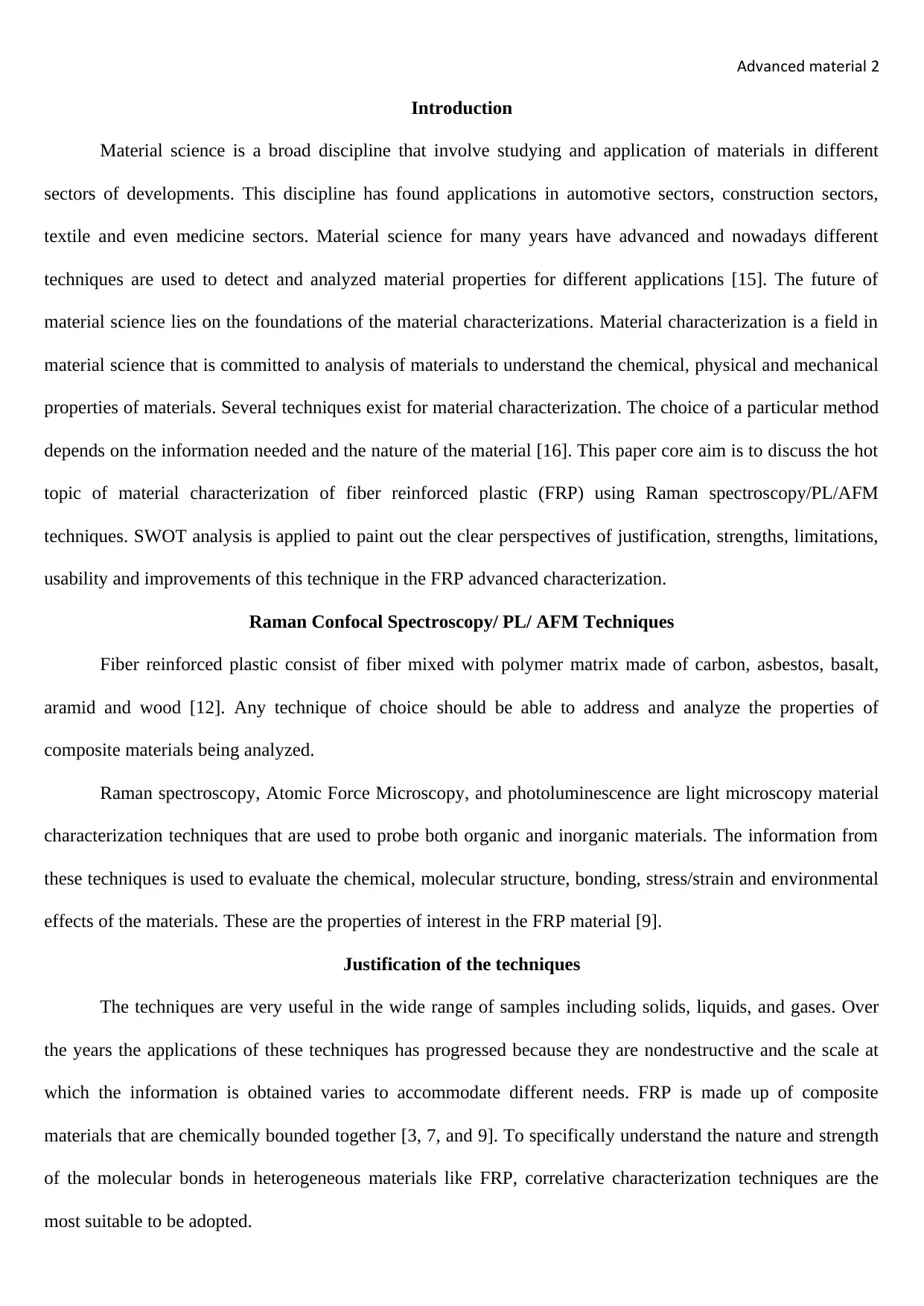
Advanced material 2
Introduction
Material science is a broad discipline that involve studying and application of materials in different
sectors of developments. This discipline has found applications in automotive sectors, construction sectors,
textile and even medicine sectors. Material science for many years have advanced and nowadays different
techniques are used to detect and analyzed material properties for different applications [15]. The future of
material science lies on the foundations of the material characterizations. Material characterization is a field in
material science that is committed to analysis of materials to understand the chemical, physical and mechanical
properties of materials. Several techniques exist for material characterization. The choice of a particular method
depends on the information needed and the nature of the material [16]. This paper core aim is to discuss the hot
topic of material characterization of fiber reinforced plastic (FRP) using Raman spectroscopy/PL/AFM
techniques. SWOT analysis is applied to paint out the clear perspectives of justification, strengths, limitations,
usability and improvements of this technique in the FRP advanced characterization.
Raman Confocal Spectroscopy/ PL/ AFM Techniques
Fiber reinforced plastic consist of fiber mixed with polymer matrix made of carbon, asbestos, basalt,
aramid and wood [12]. Any technique of choice should be able to address and analyze the properties of
composite materials being analyzed.
Raman spectroscopy, Atomic Force Microscopy, and photoluminescence are light microscopy material
characterization techniques that are used to probe both organic and inorganic materials. The information from
these techniques is used to evaluate the chemical, molecular structure, bonding, stress/strain and environmental
effects of the materials. These are the properties of interest in the FRP material [9].
Justification of the techniques
The techniques are very useful in the wide range of samples including solids, liquids, and gases. Over
the years the applications of these techniques has progressed because they are nondestructive and the scale at
which the information is obtained varies to accommodate different needs. FRP is made up of composite
materials that are chemically bounded together [3, 7, and 9]. To specifically understand the nature and strength
of the molecular bonds in heterogeneous materials like FRP, correlative characterization techniques are the
most suitable to be adopted.
Introduction
Material science is a broad discipline that involve studying and application of materials in different
sectors of developments. This discipline has found applications in automotive sectors, construction sectors,
textile and even medicine sectors. Material science for many years have advanced and nowadays different
techniques are used to detect and analyzed material properties for different applications [15]. The future of
material science lies on the foundations of the material characterizations. Material characterization is a field in
material science that is committed to analysis of materials to understand the chemical, physical and mechanical
properties of materials. Several techniques exist for material characterization. The choice of a particular method
depends on the information needed and the nature of the material [16]. This paper core aim is to discuss the hot
topic of material characterization of fiber reinforced plastic (FRP) using Raman spectroscopy/PL/AFM
techniques. SWOT analysis is applied to paint out the clear perspectives of justification, strengths, limitations,
usability and improvements of this technique in the FRP advanced characterization.
Raman Confocal Spectroscopy/ PL/ AFM Techniques
Fiber reinforced plastic consist of fiber mixed with polymer matrix made of carbon, asbestos, basalt,
aramid and wood [12]. Any technique of choice should be able to address and analyze the properties of
composite materials being analyzed.
Raman spectroscopy, Atomic Force Microscopy, and photoluminescence are light microscopy material
characterization techniques that are used to probe both organic and inorganic materials. The information from
these techniques is used to evaluate the chemical, molecular structure, bonding, stress/strain and environmental
effects of the materials. These are the properties of interest in the FRP material [9].
Justification of the techniques
The techniques are very useful in the wide range of samples including solids, liquids, and gases. Over
the years the applications of these techniques has progressed because they are nondestructive and the scale at
which the information is obtained varies to accommodate different needs. FRP is made up of composite
materials that are chemically bounded together [3, 7, and 9]. To specifically understand the nature and strength
of the molecular bonds in heterogeneous materials like FRP, correlative characterization techniques are the
most suitable to be adopted.
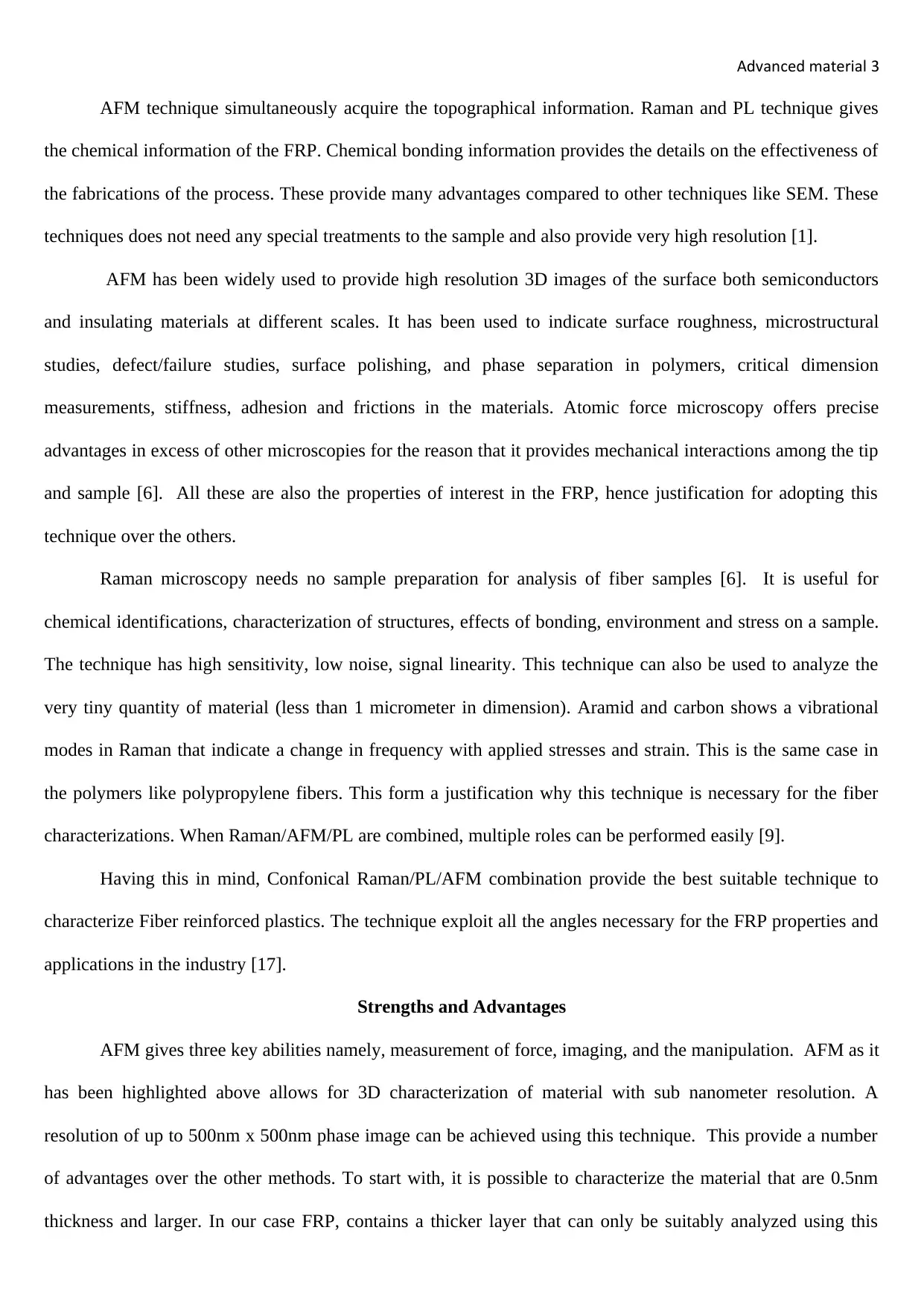
Advanced material 3
AFM technique simultaneously acquire the topographical information. Raman and PL technique gives
the chemical information of the FRP. Chemical bonding information provides the details on the effectiveness of
the fabrications of the process. These provide many advantages compared to other techniques like SEM. These
techniques does not need any special treatments to the sample and also provide very high resolution [1].
AFM has been widely used to provide high resolution 3D images of the surface both semiconductors
and insulating materials at different scales. It has been used to indicate surface roughness, microstructural
studies, defect/failure studies, surface polishing, and phase separation in polymers, critical dimension
measurements, stiffness, adhesion and frictions in the materials. Atomic force microscopy offers precise
advantages in excess of other microscopies for the reason that it provides mechanical interactions among the tip
and sample [6]. All these are also the properties of interest in the FRP, hence justification for adopting this
technique over the others.
Raman microscopy needs no sample preparation for analysis of fiber samples [6]. It is useful for
chemical identifications, characterization of structures, effects of bonding, environment and stress on a sample.
The technique has high sensitivity, low noise, signal linearity. This technique can also be used to analyze the
very tiny quantity of material (less than 1 micrometer in dimension). Aramid and carbon shows a vibrational
modes in Raman that indicate a change in frequency with applied stresses and strain. This is the same case in
the polymers like polypropylene fibers. This form a justification why this technique is necessary for the fiber
characterizations. When Raman/AFM/PL are combined, multiple roles can be performed easily [9].
Having this in mind, Confonical Raman/PL/AFM combination provide the best suitable technique to
characterize Fiber reinforced plastics. The technique exploit all the angles necessary for the FRP properties and
applications in the industry [17].
Strengths and Advantages
AFM gives three key abilities namely, measurement of force, imaging, and the manipulation. AFM as it
has been highlighted above allows for 3D characterization of material with sub nanometer resolution. A
resolution of up to 500nm x 500nm phase image can be achieved using this technique. This provide a number
of advantages over the other methods. To start with, it is possible to characterize the material that are 0.5nm
thickness and larger. In our case FRP, contains a thicker layer that can only be suitably analyzed using this
AFM technique simultaneously acquire the topographical information. Raman and PL technique gives
the chemical information of the FRP. Chemical bonding information provides the details on the effectiveness of
the fabrications of the process. These provide many advantages compared to other techniques like SEM. These
techniques does not need any special treatments to the sample and also provide very high resolution [1].
AFM has been widely used to provide high resolution 3D images of the surface both semiconductors
and insulating materials at different scales. It has been used to indicate surface roughness, microstructural
studies, defect/failure studies, surface polishing, and phase separation in polymers, critical dimension
measurements, stiffness, adhesion and frictions in the materials. Atomic force microscopy offers precise
advantages in excess of other microscopies for the reason that it provides mechanical interactions among the tip
and sample [6]. All these are also the properties of interest in the FRP, hence justification for adopting this
technique over the others.
Raman microscopy needs no sample preparation for analysis of fiber samples [6]. It is useful for
chemical identifications, characterization of structures, effects of bonding, environment and stress on a sample.
The technique has high sensitivity, low noise, signal linearity. This technique can also be used to analyze the
very tiny quantity of material (less than 1 micrometer in dimension). Aramid and carbon shows a vibrational
modes in Raman that indicate a change in frequency with applied stresses and strain. This is the same case in
the polymers like polypropylene fibers. This form a justification why this technique is necessary for the fiber
characterizations. When Raman/AFM/PL are combined, multiple roles can be performed easily [9].
Having this in mind, Confonical Raman/PL/AFM combination provide the best suitable technique to
characterize Fiber reinforced plastics. The technique exploit all the angles necessary for the FRP properties and
applications in the industry [17].
Strengths and Advantages
AFM gives three key abilities namely, measurement of force, imaging, and the manipulation. AFM as it
has been highlighted above allows for 3D characterization of material with sub nanometer resolution. A
resolution of up to 500nm x 500nm phase image can be achieved using this technique. This provide a number
of advantages over the other methods. To start with, it is possible to characterize the material that are 0.5nm
thickness and larger. In our case FRP, contains a thicker layer that can only be suitably analyzed using this
⊘ This is a preview!⊘
Do you want full access?
Subscribe today to unlock all pages.

Trusted by 1+ million students worldwide
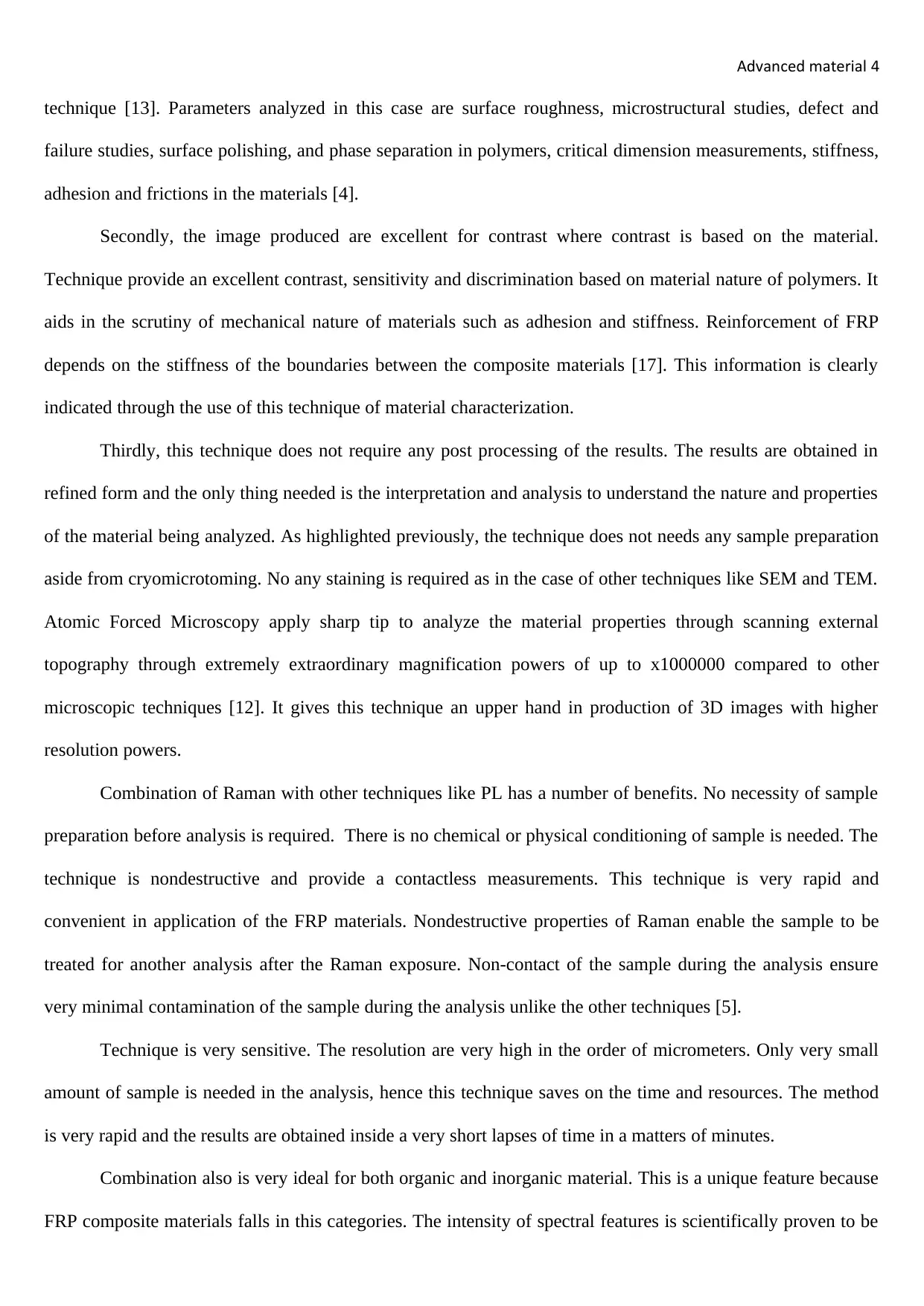
Advanced material 4
technique [13]. Parameters analyzed in this case are surface roughness, microstructural studies, defect and
failure studies, surface polishing, and phase separation in polymers, critical dimension measurements, stiffness,
adhesion and frictions in the materials [4].
Secondly, the image produced are excellent for contrast where contrast is based on the material.
Technique provide an excellent contrast, sensitivity and discrimination based on material nature of polymers. It
aids in the scrutiny of mechanical nature of materials such as adhesion and stiffness. Reinforcement of FRP
depends on the stiffness of the boundaries between the composite materials [17]. This information is clearly
indicated through the use of this technique of material characterization.
Thirdly, this technique does not require any post processing of the results. The results are obtained in
refined form and the only thing needed is the interpretation and analysis to understand the nature and properties
of the material being analyzed. As highlighted previously, the technique does not needs any sample preparation
aside from cryomicrotoming. No any staining is required as in the case of other techniques like SEM and TEM.
Atomic Forced Microscopy apply sharp tip to analyze the material properties through scanning external
topography through extremely extraordinary magnification powers of up to x1000000 compared to other
microscopic techniques [12]. It gives this technique an upper hand in production of 3D images with higher
resolution powers.
Combination of Raman with other techniques like PL has a number of benefits. No necessity of sample
preparation before analysis is required. There is no chemical or physical conditioning of sample is needed. The
technique is nondestructive and provide a contactless measurements. This technique is very rapid and
convenient in application of the FRP materials. Nondestructive properties of Raman enable the sample to be
treated for another analysis after the Raman exposure. Non-contact of the sample during the analysis ensure
very minimal contamination of the sample during the analysis unlike the other techniques [5].
Technique is very sensitive. The resolution are very high in the order of micrometers. Only very small
amount of sample is needed in the analysis, hence this technique saves on the time and resources. The method
is very rapid and the results are obtained inside a very short lapses of time in a matters of minutes.
Combination also is very ideal for both organic and inorganic material. This is a unique feature because
FRP composite materials falls in this categories. The intensity of spectral features is scientifically proven to be
technique [13]. Parameters analyzed in this case are surface roughness, microstructural studies, defect and
failure studies, surface polishing, and phase separation in polymers, critical dimension measurements, stiffness,
adhesion and frictions in the materials [4].
Secondly, the image produced are excellent for contrast where contrast is based on the material.
Technique provide an excellent contrast, sensitivity and discrimination based on material nature of polymers. It
aids in the scrutiny of mechanical nature of materials such as adhesion and stiffness. Reinforcement of FRP
depends on the stiffness of the boundaries between the composite materials [17]. This information is clearly
indicated through the use of this technique of material characterization.
Thirdly, this technique does not require any post processing of the results. The results are obtained in
refined form and the only thing needed is the interpretation and analysis to understand the nature and properties
of the material being analyzed. As highlighted previously, the technique does not needs any sample preparation
aside from cryomicrotoming. No any staining is required as in the case of other techniques like SEM and TEM.
Atomic Forced Microscopy apply sharp tip to analyze the material properties through scanning external
topography through extremely extraordinary magnification powers of up to x1000000 compared to other
microscopic techniques [12]. It gives this technique an upper hand in production of 3D images with higher
resolution powers.
Combination of Raman with other techniques like PL has a number of benefits. No necessity of sample
preparation before analysis is required. There is no chemical or physical conditioning of sample is needed. The
technique is nondestructive and provide a contactless measurements. This technique is very rapid and
convenient in application of the FRP materials. Nondestructive properties of Raman enable the sample to be
treated for another analysis after the Raman exposure. Non-contact of the sample during the analysis ensure
very minimal contamination of the sample during the analysis unlike the other techniques [5].
Technique is very sensitive. The resolution are very high in the order of micrometers. Only very small
amount of sample is needed in the analysis, hence this technique saves on the time and resources. The method
is very rapid and the results are obtained inside a very short lapses of time in a matters of minutes.
Combination also is very ideal for both organic and inorganic material. This is a unique feature because
FRP composite materials falls in this categories. The intensity of spectral features is scientifically proven to be
Paraphrase This Document
Need a fresh take? Get an instant paraphrase of this document with our AI Paraphraser
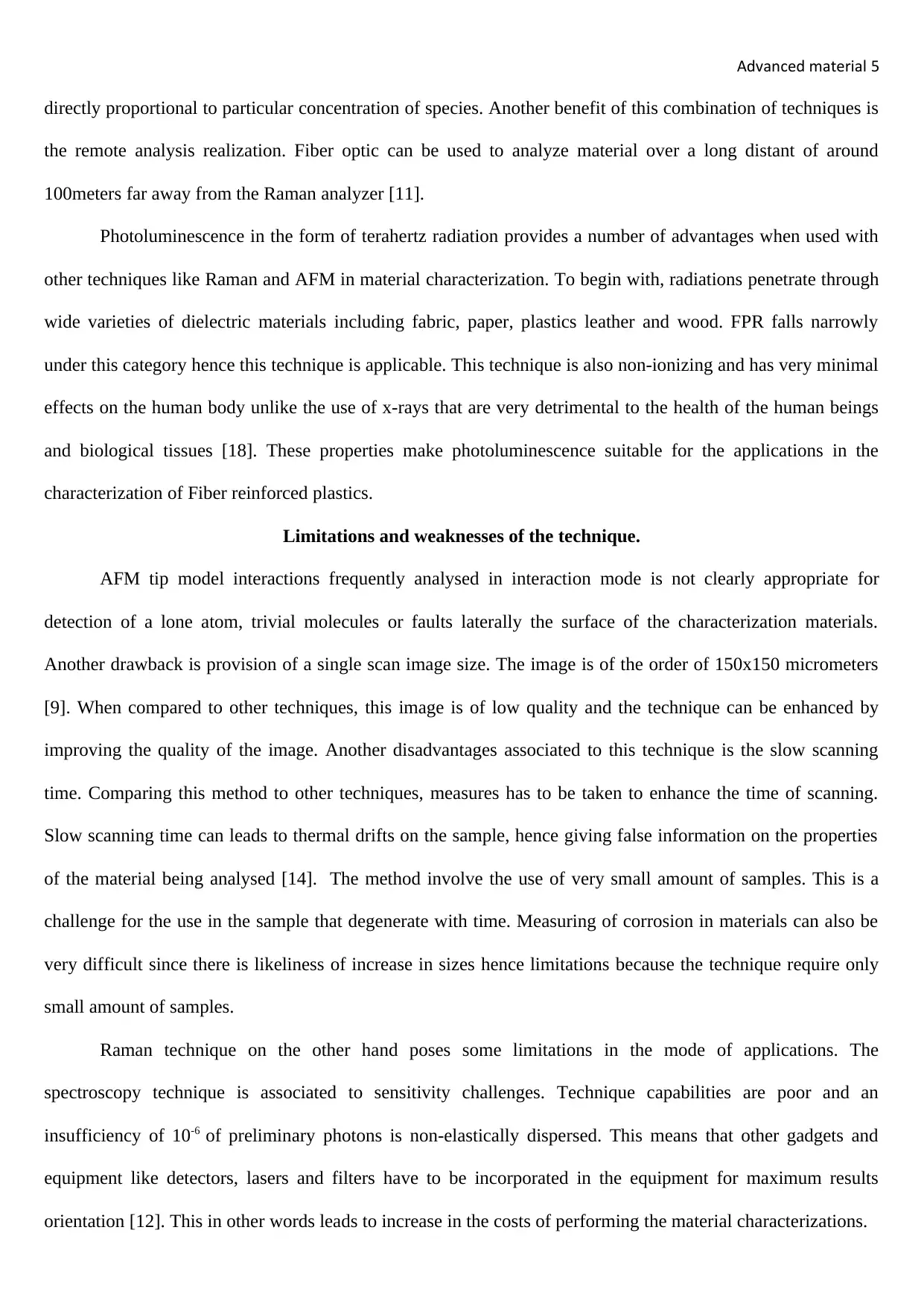
Advanced material 5
directly proportional to particular concentration of species. Another benefit of this combination of techniques is
the remote analysis realization. Fiber optic can be used to analyze material over a long distant of around
100meters far away from the Raman analyzer [11].
Photoluminescence in the form of terahertz radiation provides a number of advantages when used with
other techniques like Raman and AFM in material characterization. To begin with, radiations penetrate through
wide varieties of dielectric materials including fabric, paper, plastics leather and wood. FPR falls narrowly
under this category hence this technique is applicable. This technique is also non-ionizing and has very minimal
effects on the human body unlike the use of x-rays that are very detrimental to the health of the human beings
and biological tissues [18]. These properties make photoluminescence suitable for the applications in the
characterization of Fiber reinforced plastics.
Limitations and weaknesses of the technique.
AFM tip model interactions frequently analysed in interaction mode is not clearly appropriate for
detection of a lone atom, trivial molecules or faults laterally the surface of the characterization materials.
Another drawback is provision of a single scan image size. The image is of the order of 150x150 micrometers
[9]. When compared to other techniques, this image is of low quality and the technique can be enhanced by
improving the quality of the image. Another disadvantages associated to this technique is the slow scanning
time. Comparing this method to other techniques, measures has to be taken to enhance the time of scanning.
Slow scanning time can leads to thermal drifts on the sample, hence giving false information on the properties
of the material being analysed [14]. The method involve the use of very small amount of samples. This is a
challenge for the use in the sample that degenerate with time. Measuring of corrosion in materials can also be
very difficult since there is likeliness of increase in sizes hence limitations because the technique require only
small amount of samples.
Raman technique on the other hand poses some limitations in the mode of applications. The
spectroscopy technique is associated to sensitivity challenges. Technique capabilities are poor and an
insufficiency of 10-6 of preliminary photons is non-elastically dispersed. This means that other gadgets and
equipment like detectors, lasers and filters have to be incorporated in the equipment for maximum results
orientation [12]. This in other words leads to increase in the costs of performing the material characterizations.
directly proportional to particular concentration of species. Another benefit of this combination of techniques is
the remote analysis realization. Fiber optic can be used to analyze material over a long distant of around
100meters far away from the Raman analyzer [11].
Photoluminescence in the form of terahertz radiation provides a number of advantages when used with
other techniques like Raman and AFM in material characterization. To begin with, radiations penetrate through
wide varieties of dielectric materials including fabric, paper, plastics leather and wood. FPR falls narrowly
under this category hence this technique is applicable. This technique is also non-ionizing and has very minimal
effects on the human body unlike the use of x-rays that are very detrimental to the health of the human beings
and biological tissues [18]. These properties make photoluminescence suitable for the applications in the
characterization of Fiber reinforced plastics.
Limitations and weaknesses of the technique.
AFM tip model interactions frequently analysed in interaction mode is not clearly appropriate for
detection of a lone atom, trivial molecules or faults laterally the surface of the characterization materials.
Another drawback is provision of a single scan image size. The image is of the order of 150x150 micrometers
[9]. When compared to other techniques, this image is of low quality and the technique can be enhanced by
improving the quality of the image. Another disadvantages associated to this technique is the slow scanning
time. Comparing this method to other techniques, measures has to be taken to enhance the time of scanning.
Slow scanning time can leads to thermal drifts on the sample, hence giving false information on the properties
of the material being analysed [14]. The method involve the use of very small amount of samples. This is a
challenge for the use in the sample that degenerate with time. Measuring of corrosion in materials can also be
very difficult since there is likeliness of increase in sizes hence limitations because the technique require only
small amount of samples.
Raman technique on the other hand poses some limitations in the mode of applications. The
spectroscopy technique is associated to sensitivity challenges. Technique capabilities are poor and an
insufficiency of 10-6 of preliminary photons is non-elastically dispersed. This means that other gadgets and
equipment like detectors, lasers and filters have to be incorporated in the equipment for maximum results
orientation [12]. This in other words leads to increase in the costs of performing the material characterizations.

Advanced material 6
Secondly, Raman is used together with fluorescence to generate the signals. This attracts other
limitation linked to this application. During the analysis, there exist a competing process between the Raman
scattering and fluorescence signals. This competing scenario in the process delay the efficiencies of the
analysis. The solution to this problem is the selection of the appropriate wavelengths with lower photon energy.
As the wavelength excitation became shorter, Raman scattering intensity increases and fluorescence become
less troublesome as the laser wavelength increases in the size [13]. The problem with fluorescence can also be
overcome by adopting a spectroscopy with more than one or several lasers.
Another challenge of this method is the selectivity of the material. This technique can be used in a wide
variety of materials. However, some metals and alloys are not Raman active hence cannot be characterized
using this technique [8].
PL has shown tremendous progress in its applications. However, a number of drawbacks are pulling this
progress behind. To start with, detection of radiations is sometimes difficulty since blackbody radiation in the
ambient temperatures is strong on the terahertz frequencies, hence posing a challenge in the applications. This
calls for the improvements to the ratio terahertz images can be able to detect. This solution is however,
applicable only for the static materials. The atmospheric attenuation of the radiation is much more lethal than in
the spectral regions like infrared radiation and visible light regions. This technique has also the limitations of
selection of particular optics in the imaging systems. Lens in PL are rarely applied extensively in the terahertz
system for the reason that lack of suitable materials and anti-reflection coatings effective over extensive series
of frequencies [1 and 3]. Complications in the construction of progressive lenses are related with one of the best
important curbs of THz methods, which is measurement resolution.
Improvements and opportunities.
The major improvements in the techniques used for FRP characterization are associated to the
advancement of the technology. As we move deeper to the digital era, more sophisticated technology and
gadgets are being incorporated to Raman, AFM and PL for better characterization of the materials. Recently,
Raman has been made with capabilities to characterize material with little or no noise at all. Major drawbacks
associated to Raman are the size of the sample, speed, cost and self-conflicting with the fluorescence signals
[5].
Secondly, Raman is used together with fluorescence to generate the signals. This attracts other
limitation linked to this application. During the analysis, there exist a competing process between the Raman
scattering and fluorescence signals. This competing scenario in the process delay the efficiencies of the
analysis. The solution to this problem is the selection of the appropriate wavelengths with lower photon energy.
As the wavelength excitation became shorter, Raman scattering intensity increases and fluorescence become
less troublesome as the laser wavelength increases in the size [13]. The problem with fluorescence can also be
overcome by adopting a spectroscopy with more than one or several lasers.
Another challenge of this method is the selectivity of the material. This technique can be used in a wide
variety of materials. However, some metals and alloys are not Raman active hence cannot be characterized
using this technique [8].
PL has shown tremendous progress in its applications. However, a number of drawbacks are pulling this
progress behind. To start with, detection of radiations is sometimes difficulty since blackbody radiation in the
ambient temperatures is strong on the terahertz frequencies, hence posing a challenge in the applications. This
calls for the improvements to the ratio terahertz images can be able to detect. This solution is however,
applicable only for the static materials. The atmospheric attenuation of the radiation is much more lethal than in
the spectral regions like infrared radiation and visible light regions. This technique has also the limitations of
selection of particular optics in the imaging systems. Lens in PL are rarely applied extensively in the terahertz
system for the reason that lack of suitable materials and anti-reflection coatings effective over extensive series
of frequencies [1 and 3]. Complications in the construction of progressive lenses are related with one of the best
important curbs of THz methods, which is measurement resolution.
Improvements and opportunities.
The major improvements in the techniques used for FRP characterization are associated to the
advancement of the technology. As we move deeper to the digital era, more sophisticated technology and
gadgets are being incorporated to Raman, AFM and PL for better characterization of the materials. Recently,
Raman has been made with capabilities to characterize material with little or no noise at all. Major drawbacks
associated to Raman are the size of the sample, speed, cost and self-conflicting with the fluorescence signals
[5].
⊘ This is a preview!⊘
Do you want full access?
Subscribe today to unlock all pages.

Trusted by 1+ million students worldwide
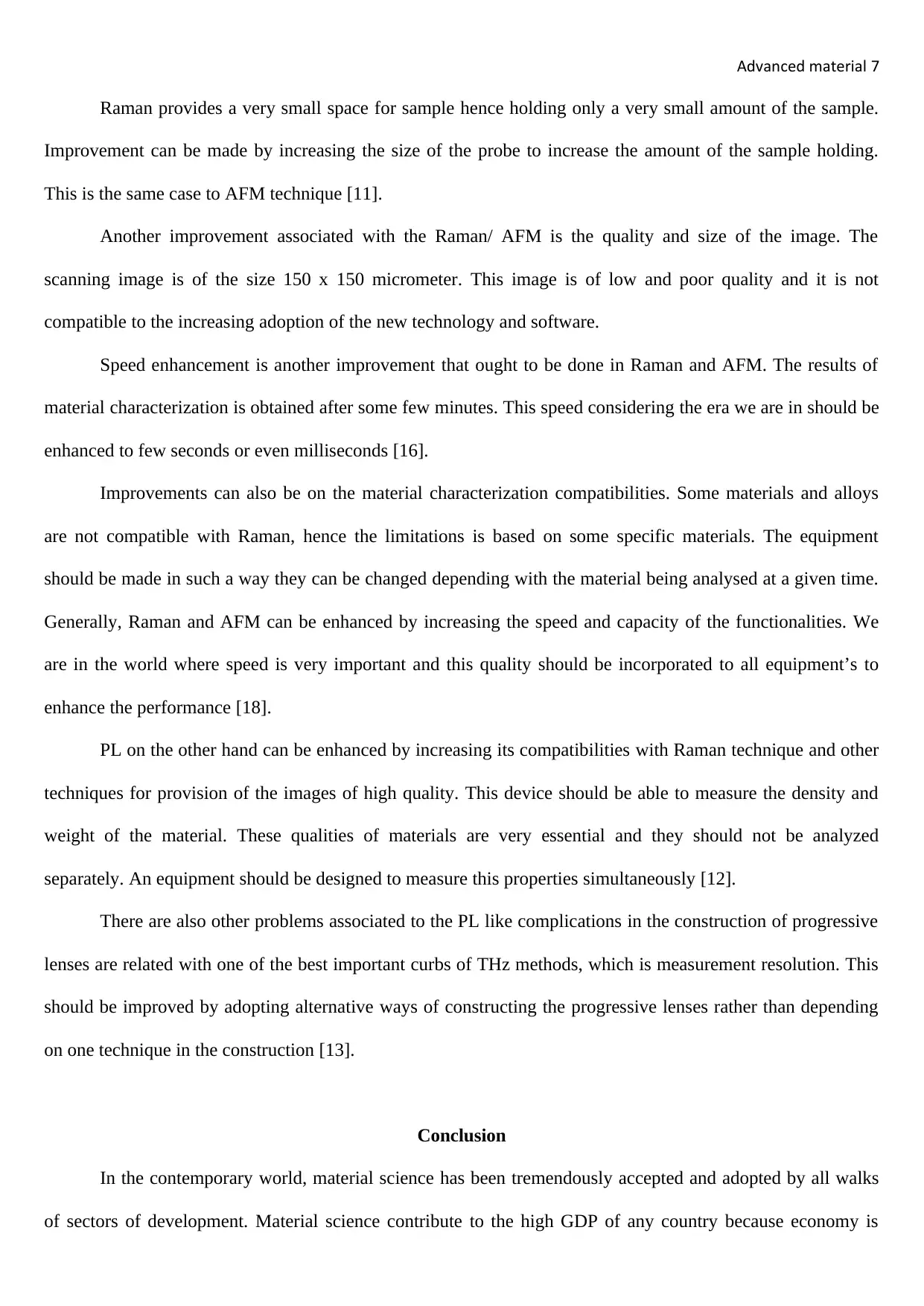
Advanced material 7
Raman provides a very small space for sample hence holding only a very small amount of the sample.
Improvement can be made by increasing the size of the probe to increase the amount of the sample holding.
This is the same case to AFM technique [11].
Another improvement associated with the Raman/ AFM is the quality and size of the image. The
scanning image is of the size 150 x 150 micrometer. This image is of low and poor quality and it is not
compatible to the increasing adoption of the new technology and software.
Speed enhancement is another improvement that ought to be done in Raman and AFM. The results of
material characterization is obtained after some few minutes. This speed considering the era we are in should be
enhanced to few seconds or even milliseconds [16].
Improvements can also be on the material characterization compatibilities. Some materials and alloys
are not compatible with Raman, hence the limitations is based on some specific materials. The equipment
should be made in such a way they can be changed depending with the material being analysed at a given time.
Generally, Raman and AFM can be enhanced by increasing the speed and capacity of the functionalities. We
are in the world where speed is very important and this quality should be incorporated to all equipment’s to
enhance the performance [18].
PL on the other hand can be enhanced by increasing its compatibilities with Raman technique and other
techniques for provision of the images of high quality. This device should be able to measure the density and
weight of the material. These qualities of materials are very essential and they should not be analyzed
separately. An equipment should be designed to measure this properties simultaneously [12].
There are also other problems associated to the PL like complications in the construction of progressive
lenses are related with one of the best important curbs of THz methods, which is measurement resolution. This
should be improved by adopting alternative ways of constructing the progressive lenses rather than depending
on one technique in the construction [13].
Conclusion
In the contemporary world, material science has been tremendously accepted and adopted by all walks
of sectors of development. Material science contribute to the high GDP of any country because economy is
Raman provides a very small space for sample hence holding only a very small amount of the sample.
Improvement can be made by increasing the size of the probe to increase the amount of the sample holding.
This is the same case to AFM technique [11].
Another improvement associated with the Raman/ AFM is the quality and size of the image. The
scanning image is of the size 150 x 150 micrometer. This image is of low and poor quality and it is not
compatible to the increasing adoption of the new technology and software.
Speed enhancement is another improvement that ought to be done in Raman and AFM. The results of
material characterization is obtained after some few minutes. This speed considering the era we are in should be
enhanced to few seconds or even milliseconds [16].
Improvements can also be on the material characterization compatibilities. Some materials and alloys
are not compatible with Raman, hence the limitations is based on some specific materials. The equipment
should be made in such a way they can be changed depending with the material being analysed at a given time.
Generally, Raman and AFM can be enhanced by increasing the speed and capacity of the functionalities. We
are in the world where speed is very important and this quality should be incorporated to all equipment’s to
enhance the performance [18].
PL on the other hand can be enhanced by increasing its compatibilities with Raman technique and other
techniques for provision of the images of high quality. This device should be able to measure the density and
weight of the material. These qualities of materials are very essential and they should not be analyzed
separately. An equipment should be designed to measure this properties simultaneously [12].
There are also other problems associated to the PL like complications in the construction of progressive
lenses are related with one of the best important curbs of THz methods, which is measurement resolution. This
should be improved by adopting alternative ways of constructing the progressive lenses rather than depending
on one technique in the construction [13].
Conclusion
In the contemporary world, material science has been tremendously accepted and adopted by all walks
of sectors of development. Material science contribute to the high GDP of any country because economy is
Paraphrase This Document
Need a fresh take? Get an instant paraphrase of this document with our AI Paraphraser
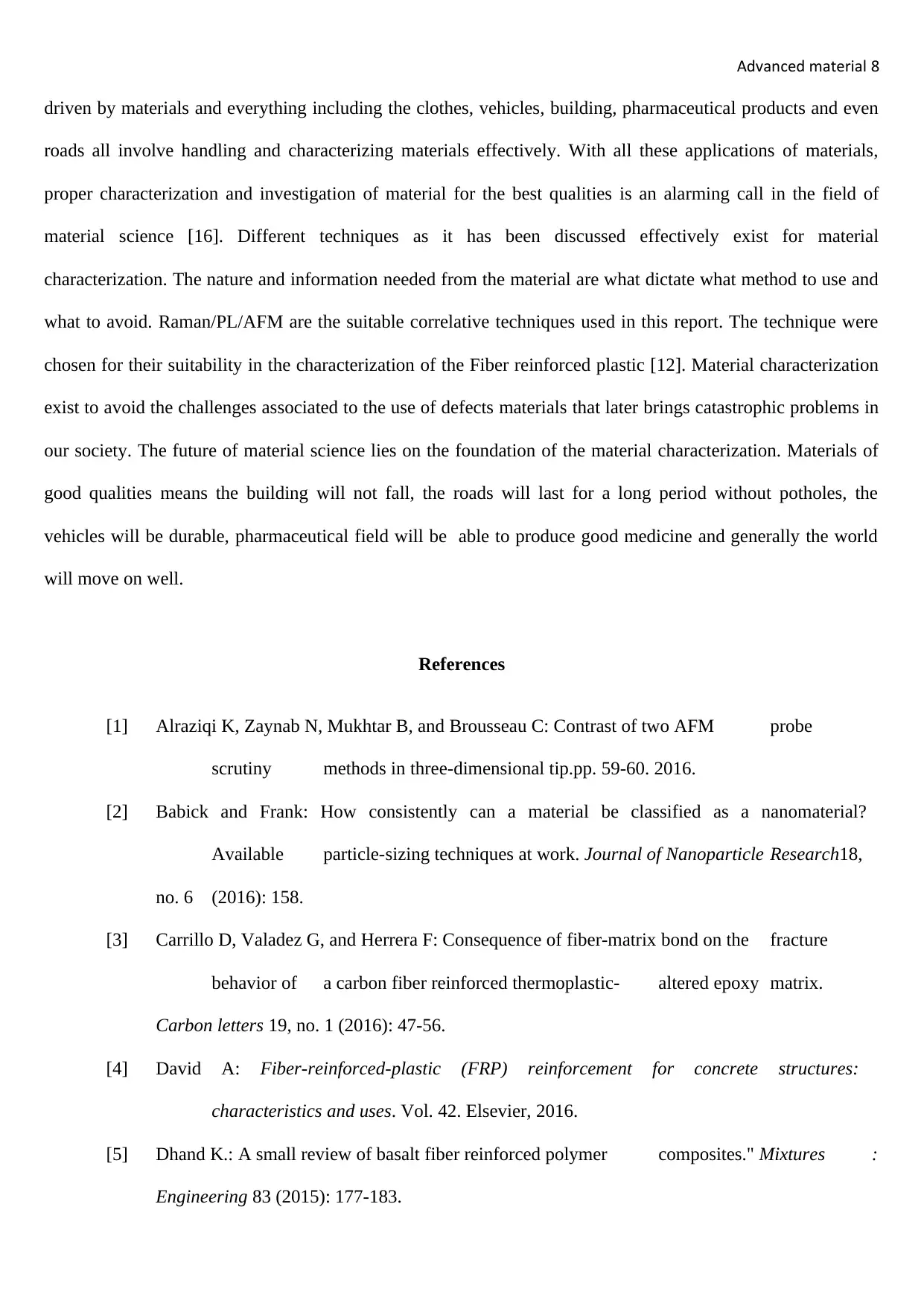
Advanced material 8
driven by materials and everything including the clothes, vehicles, building, pharmaceutical products and even
roads all involve handling and characterizing materials effectively. With all these applications of materials,
proper characterization and investigation of material for the best qualities is an alarming call in the field of
material science [16]. Different techniques as it has been discussed effectively exist for material
characterization. The nature and information needed from the material are what dictate what method to use and
what to avoid. Raman/PL/AFM are the suitable correlative techniques used in this report. The technique were
chosen for their suitability in the characterization of the Fiber reinforced plastic [12]. Material characterization
exist to avoid the challenges associated to the use of defects materials that later brings catastrophic problems in
our society. The future of material science lies on the foundation of the material characterization. Materials of
good qualities means the building will not fall, the roads will last for a long period without potholes, the
vehicles will be durable, pharmaceutical field will be able to produce good medicine and generally the world
will move on well.
References
[1] Alraziqi K, Zaynab N, Mukhtar B, and Brousseau C: Contrast of two AFM probe
scrutiny methods in three-dimensional tip.pp. 59-60. 2016.
[2] Babick and Frank: How consistently can a material be classified as a nanomaterial?
Available particle-sizing techniques at work. Journal of Nanoparticle Research18,
no. 6 (2016): 158.
[3] Carrillo D, Valadez G, and Herrera F: Consequence of fiber-matrix bond on the fracture
behavior of a carbon fiber reinforced thermoplastic- altered epoxy matrix.
Carbon letters 19, no. 1 (2016): 47-56.
[4] David A: Fiber-reinforced-plastic (FRP) reinforcement for concrete structures:
characteristics and uses. Vol. 42. Elsevier, 2016.
[5] Dhand K.: A small review of basalt fiber reinforced polymer composites." Mixtures :
Engineering 83 (2015): 177-183.
driven by materials and everything including the clothes, vehicles, building, pharmaceutical products and even
roads all involve handling and characterizing materials effectively. With all these applications of materials,
proper characterization and investigation of material for the best qualities is an alarming call in the field of
material science [16]. Different techniques as it has been discussed effectively exist for material
characterization. The nature and information needed from the material are what dictate what method to use and
what to avoid. Raman/PL/AFM are the suitable correlative techniques used in this report. The technique were
chosen for their suitability in the characterization of the Fiber reinforced plastic [12]. Material characterization
exist to avoid the challenges associated to the use of defects materials that later brings catastrophic problems in
our society. The future of material science lies on the foundation of the material characterization. Materials of
good qualities means the building will not fall, the roads will last for a long period without potholes, the
vehicles will be durable, pharmaceutical field will be able to produce good medicine and generally the world
will move on well.
References
[1] Alraziqi K, Zaynab N, Mukhtar B, and Brousseau C: Contrast of two AFM probe
scrutiny methods in three-dimensional tip.pp. 59-60. 2016.
[2] Babick and Frank: How consistently can a material be classified as a nanomaterial?
Available particle-sizing techniques at work. Journal of Nanoparticle Research18,
no. 6 (2016): 158.
[3] Carrillo D, Valadez G, and Herrera F: Consequence of fiber-matrix bond on the fracture
behavior of a carbon fiber reinforced thermoplastic- altered epoxy matrix.
Carbon letters 19, no. 1 (2016): 47-56.
[4] David A: Fiber-reinforced-plastic (FRP) reinforcement for concrete structures:
characteristics and uses. Vol. 42. Elsevier, 2016.
[5] Dhand K.: A small review of basalt fiber reinforced polymer composites." Mixtures :
Engineering 83 (2015): 177-183.
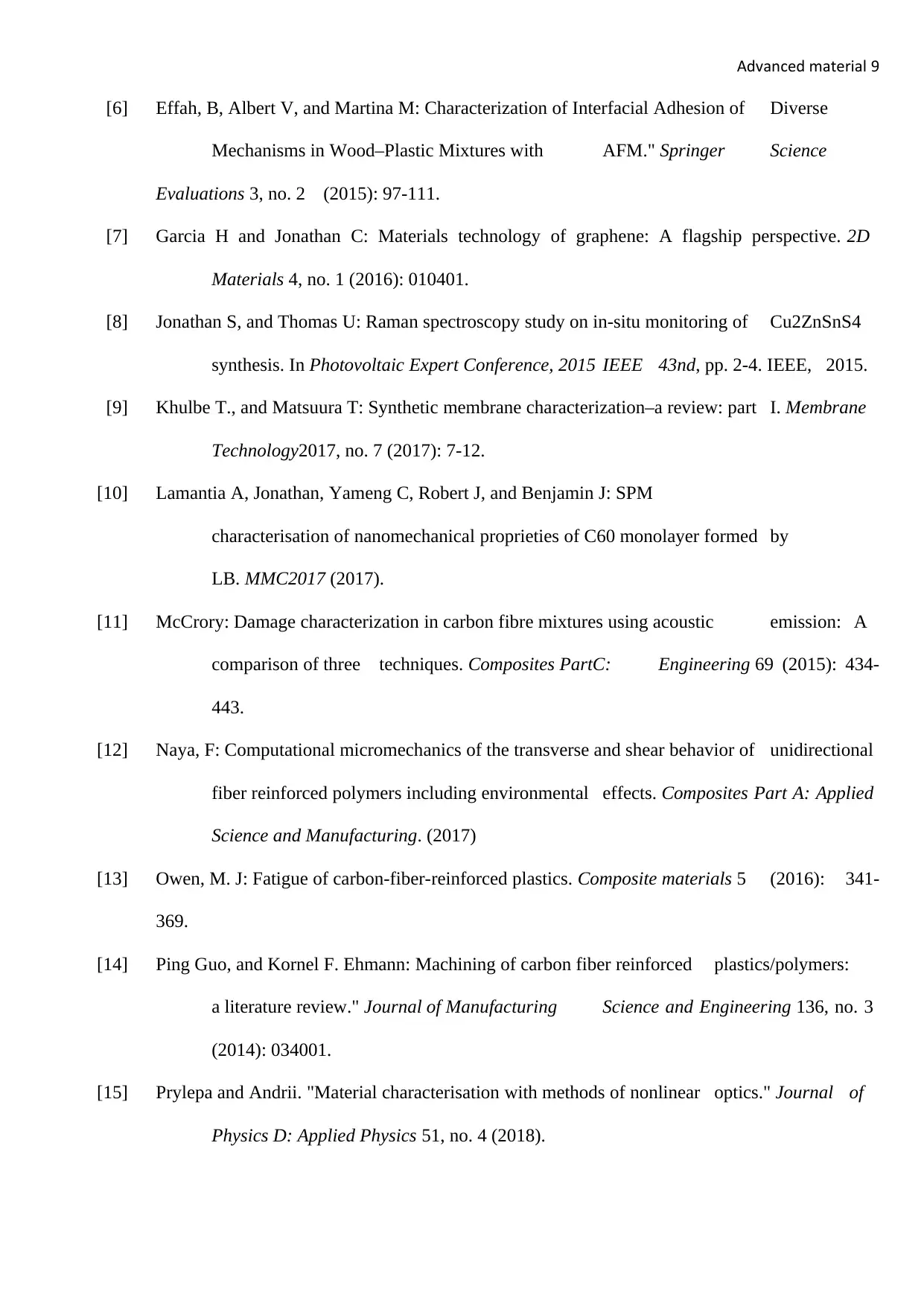
Advanced material 9
[6] Effah, B, Albert V, and Martina M: Characterization of Interfacial Adhesion of Diverse
Mechanisms in Wood–Plastic Mixtures with AFM." Springer Science
Evaluations 3, no. 2 (2015): 97-111.
[7] Garcia H and Jonathan C: Materials technology of graphene: A flagship perspective. 2D
Materials 4, no. 1 (2016): 010401.
[8] Jonathan S, and Thomas U: Raman spectroscopy study on in-situ monitoring of Cu2ZnSnS4
synthesis. In Photovoltaic Expert Conference, 2015 IEEE 43nd, pp. 2-4. IEEE, 2015.
[9] Khulbe T., and Matsuura T: Synthetic membrane characterization–a review: part I. Membrane
Technology2017, no. 7 (2017): 7-12.
[10] Lamantia A, Jonathan, Yameng C, Robert J, and Benjamin J: SPM
characterisation of nanomechanical proprieties of C60 monolayer formed by
LB. MMC2017 (2017).
[11] McCrory: Damage characterization in carbon fibre mixtures using acoustic emission: A
comparison of three techniques. Composites PartC: Engineering 69 (2015): 434-
443.
[12] Naya, F: Computational micromechanics of the transverse and shear behavior of unidirectional
fiber reinforced polymers including environmental effects. Composites Part A: Applied
Science and Manufacturing. (2017)
[13] Owen, M. J: Fatigue of carbon-fiber-reinforced plastics. Composite materials 5 (2016): 341-
369.
[14] Ping Guo, and Kornel F. Ehmann: Machining of carbon fiber reinforced plastics/polymers:
a literature review." Journal of Manufacturing Science and Engineering 136, no. 3
(2014): 034001.
[15] Prylepa and Andrii. "Material characterisation with methods of nonlinear optics." Journal of
Physics D: Applied Physics 51, no. 4 (2018).
[6] Effah, B, Albert V, and Martina M: Characterization of Interfacial Adhesion of Diverse
Mechanisms in Wood–Plastic Mixtures with AFM." Springer Science
Evaluations 3, no. 2 (2015): 97-111.
[7] Garcia H and Jonathan C: Materials technology of graphene: A flagship perspective. 2D
Materials 4, no. 1 (2016): 010401.
[8] Jonathan S, and Thomas U: Raman spectroscopy study on in-situ monitoring of Cu2ZnSnS4
synthesis. In Photovoltaic Expert Conference, 2015 IEEE 43nd, pp. 2-4. IEEE, 2015.
[9] Khulbe T., and Matsuura T: Synthetic membrane characterization–a review: part I. Membrane
Technology2017, no. 7 (2017): 7-12.
[10] Lamantia A, Jonathan, Yameng C, Robert J, and Benjamin J: SPM
characterisation of nanomechanical proprieties of C60 monolayer formed by
LB. MMC2017 (2017).
[11] McCrory: Damage characterization in carbon fibre mixtures using acoustic emission: A
comparison of three techniques. Composites PartC: Engineering 69 (2015): 434-
443.
[12] Naya, F: Computational micromechanics of the transverse and shear behavior of unidirectional
fiber reinforced polymers including environmental effects. Composites Part A: Applied
Science and Manufacturing. (2017)
[13] Owen, M. J: Fatigue of carbon-fiber-reinforced plastics. Composite materials 5 (2016): 341-
369.
[14] Ping Guo, and Kornel F. Ehmann: Machining of carbon fiber reinforced plastics/polymers:
a literature review." Journal of Manufacturing Science and Engineering 136, no. 3
(2014): 034001.
[15] Prylepa and Andrii. "Material characterisation with methods of nonlinear optics." Journal of
Physics D: Applied Physics 51, no. 4 (2018).
⊘ This is a preview!⊘
Do you want full access?
Subscribe today to unlock all pages.

Trusted by 1+ million students worldwide
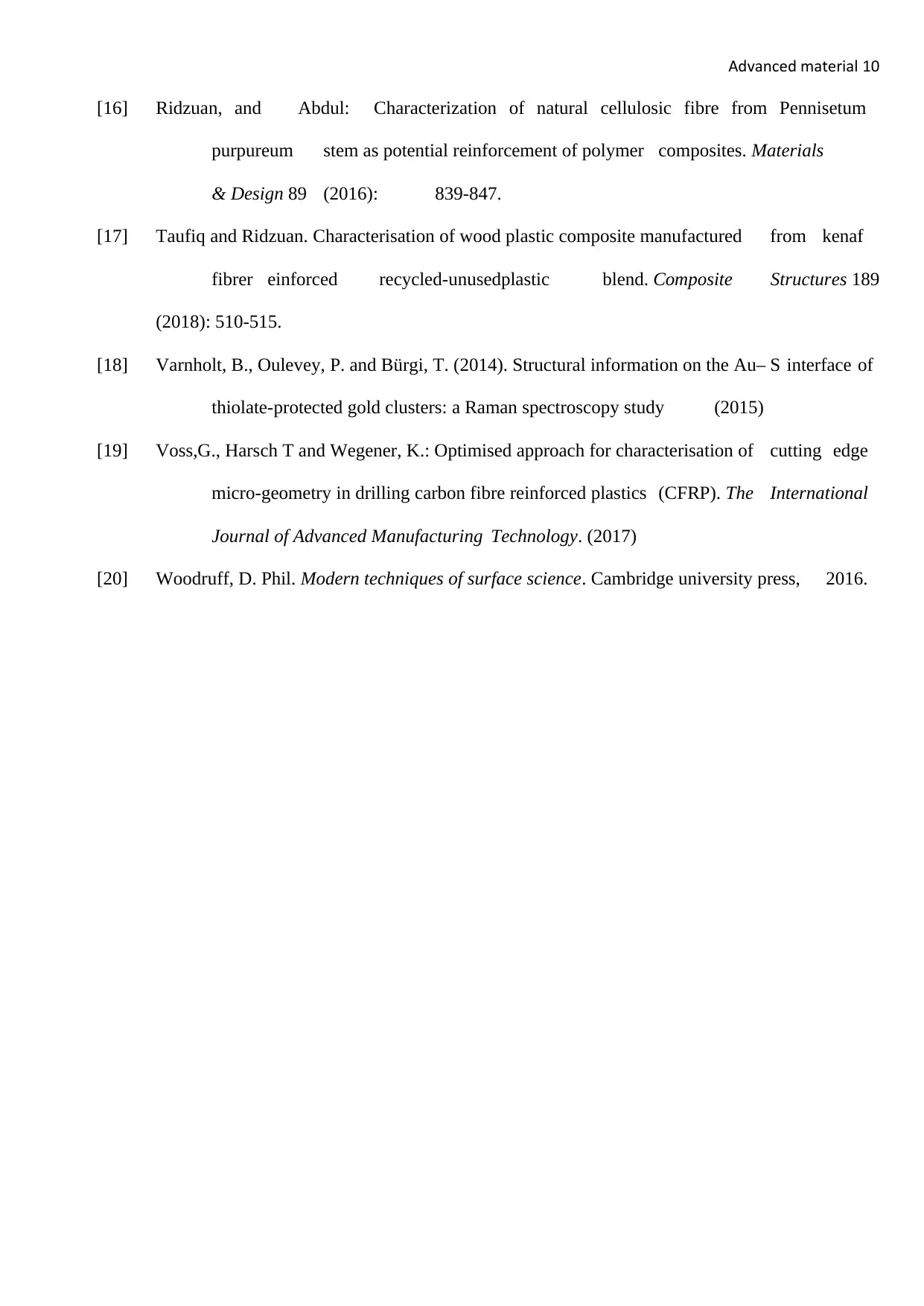
Advanced material 10
[16] Ridzuan, and Abdul: Characterization of natural cellulosic fibre from Pennisetum
purpureum stem as potential reinforcement of polymer composites. Materials
& Design 89 (2016): 839-847.
[17] Taufiq and Ridzuan. Characterisation of wood plastic composite manufactured from kenaf
fibrer einforced recycled-unusedplastic blend. Composite Structures 189
(2018): 510-515.
[18] Varnholt, B., Oulevey, P. and Bürgi, T. (2014). Structural information on the Au– S interface of
thiolate-protected gold clusters: a Raman spectroscopy study (2015)
[19] Voss,G., Harsch T and Wegener, K.: Optimised approach for characterisation of cutting edge
micro-geometry in drilling carbon fibre reinforced plastics (CFRP). The International
Journal of Advanced Manufacturing Technology. (2017)
[20] Woodruff, D. Phil. Modern techniques of surface science. Cambridge university press, 2016.
[16] Ridzuan, and Abdul: Characterization of natural cellulosic fibre from Pennisetum
purpureum stem as potential reinforcement of polymer composites. Materials
& Design 89 (2016): 839-847.
[17] Taufiq and Ridzuan. Characterisation of wood plastic composite manufactured from kenaf
fibrer einforced recycled-unusedplastic blend. Composite Structures 189
(2018): 510-515.
[18] Varnholt, B., Oulevey, P. and Bürgi, T. (2014). Structural information on the Au– S interface of
thiolate-protected gold clusters: a Raman spectroscopy study (2015)
[19] Voss,G., Harsch T and Wegener, K.: Optimised approach for characterisation of cutting edge
micro-geometry in drilling carbon fibre reinforced plastics (CFRP). The International
Journal of Advanced Manufacturing Technology. (2017)
[20] Woodruff, D. Phil. Modern techniques of surface science. Cambridge university press, 2016.
1 out of 10
Your All-in-One AI-Powered Toolkit for Academic Success.
+13062052269
info@desklib.com
Available 24*7 on WhatsApp / Email
![[object Object]](/_next/static/media/star-bottom.7253800d.svg)
Unlock your academic potential
Copyright © 2020–2025 A2Z Services. All Rights Reserved. Developed and managed by ZUCOL.


